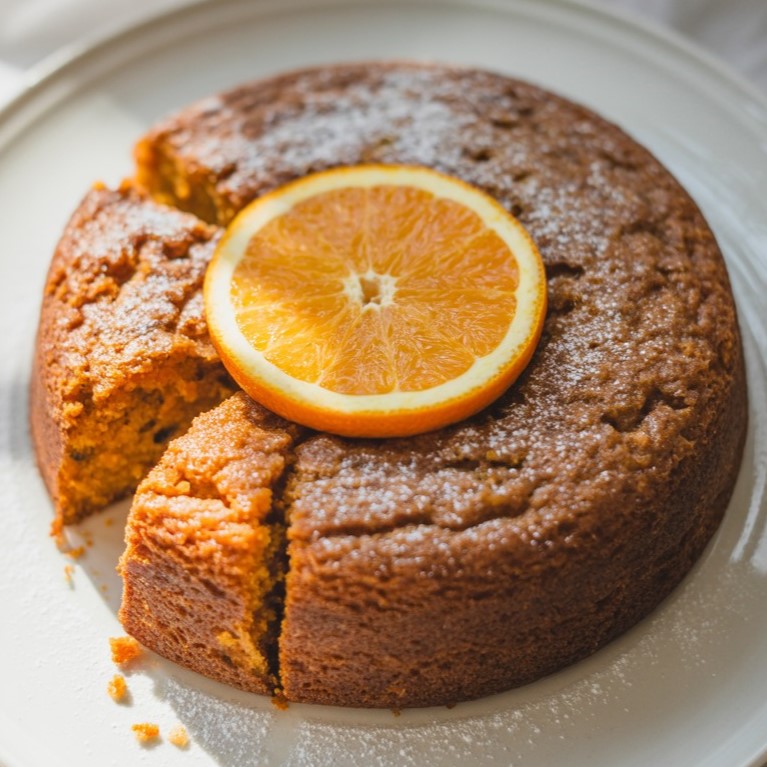My late brother always said Spotted Dick was the only dessert that could make him feel both full and nostalgic at the same time. We used to joke that it looked like a steamed raisin brick—but we’d always reach for seconds.
I remember one Sunday afternoon when we tried to make it together without mum’s recipe. We fumbled through vague memories, stained notes, and guessing games. The result? Slightly undercooked in the middle, but delicious all the same. We ate it by the fireplace, steaming custard poured generously over each slice, laughing at how we had to scrape the edges from the basin with a spoon.
Now, years later, I make it in my quiet kitchen, the windows fogged up from the pot steaming on the hob. I still hear his voice when I unwrap the foil—“You remembered the lemon zest this time, didn’t you?” This pudding carries a quiet strength: no fuss, no frills, just humble ingredients coming together into something rich and comforting.
I often think recipes like this are anchors. They tether us to people and places that time tries to erase. Making Spotted Dick is my way of honoring those moments—keeping traditions alive, one pudding at a time.

Short Description
Traditional Spotted Dick is a classic British steamed suet pudding studded with currants and flavored with a hint of lemon zest. Served warm with creamy custard, it’s a nostalgic comfort dessert with a rich, tender crumb and deep flavor.
Key Ingredients
For the Pudding:
- 250g self-raising flour
- 125g suet (vegetarian suet works too)
- 150g currants or raisins
- A pinch of salt
- 1 tsp lemon zest
- 150ml whole milk
- 50g caster sugar
For Steaming:
- Butter (for greasing)
- Water (for steaming)
To Serve:
-
Custard (either homemade or shop-bought)
Tools Needed
- 1-litre pudding basin
- Large mixing bowl
- Wooden spoon or spatula
- Kitchen string
- Parchment paper
- Foil
- Deep pot with lid (for steaming)
- Trivet or heat-safe plate (for elevating basin inside pot)
Cooking Instructions
Step 1: Prepare the Pudding Basin
Grease your 1-litre pudding basin thoroughly with butter, making sure to coat the sides and bottom well to prevent sticking.
Step 2: Mix the Dry Ingredients
In a large mixing bowl, combine the self-raising flour, suet, caster sugar, a pinch of salt, lemon zest, and currants or raisins. Give everything a good stir so the fruit is evenly distributed.
Step 3: Form the Dough
Gradually pour in the milk while mixing, until a soft, firm dough comes together. The dough should hold its shape but not be sticky. If it feels too dry, add a splash more milk. If too wet, dust with a little extra flour.
Step 4: Fill the Basin
Transfer the dough into the greased pudding basin, pressing it down gently and leveling the top. Don’t pack it too tightly—give it a bit of room to expand.
Step 5: Cover the Pudding
Cut a round of parchment paper large enough to cover the top with an overhang. Butter one side and place it butter-side down on the pudding. Cover that with a piece of foil, then tie string around the basin to secure both layers tightly. Add a handle with string if desired, to make lifting easier.
Step 6: Steam the Pudding
Place a trivet or upturned plate in the bottom of a deep pot and fill with boiling water until it reaches halfway up the sides of the basin. Carefully lower the basin into the pot. Cover with a lid and steam over gentle heat for 1½ to 2 hours. Top up the water as needed.
Step 7: Unmold and Serve
Carefully lift the basin out and let it rest for a minute. Remove the foil and parchment. Run a knife around the edges and gently turn the pudding onto a serving dish. Slice and serve warm with lots of creamy custard.
Why You’ll Love This Recipe
– Deeply nostalgic with rich, comforting flavors
– Easy to make with pantry staples
– Naturally vegetarian-friendly (with veggie suet)
– Lovely texture—soft, hearty, and slightly crumbly
– Perfect for cozy gatherings, rainy evenings, or holiday tables
Mistakes to Avoid & Solutions
1. Dough Too Wet or Dry
Solution: Add milk slowly and adjust as needed. The dough should be soft but not sticky.
2. Skipping the Grease
Solution: Thoroughly butter the basin or your pudding may stick. Even parchment can’t save it if the basin is dry.
3. Water Boils Dry While Steaming
Solution: Check the water level every 30 minutes and top up with boiling water as needed.
4. Foil Not Sealed Properly
Solution: Ensure a tight seal with parchment and foil, and tie with string to avoid water seeping in.
5. Undercooking
Solution: Steam for the full 1½ to 2 hours. A toothpick inserted into the center should come out clean.
Serving and Pairing Suggestions
Serve warm with classic English custard—either homemade or a good-quality store-bought version.
Add a drizzle of double cream for extra richness.
Pair with a cup of Earl Grey or a dessert wine.
Ideal for a cozy dinner party dessert, served family-style on a platter.
You can also serve it buffet-style, pre-sliced with custard on the side.
Storage and Reheating Tips
To Store: Wrap leftovers tightly in cling film or place in an airtight container. Store in the fridge for up to 4 days.
To Freeze: Wrap in foil and freeze for up to 2 months. Thaw overnight in the fridge.
To Reheat (Microwave): Slice and heat individual portions on medium for 1 minute.
To Reheat (Steam): Steam whole pudding again for 20–30 minutes until warmed through.
To Reheat (Oven): Wrap in foil and bake at 160°C (320°F) for 20 minutes.
FAQs
1. Can I make this without suet?
Yes, you can substitute butter, though the texture will be softer. Freeze the butter and grate it into the flour for best results.
2. What’s the best substitute for currants?
Raisins, sultanas, or chopped dried apricots work well. Just keep the same quantity.
3. Can I make this gluten-free?
Use a gluten-free self-raising flour blend. Add ¼ tsp xanthan gum if your blend doesn’t already include it.
4. Is it okay to use a metal basin instead of ceramic?
Absolutely. Just ensure it’s well-greased and covered securely.
5. Can I steam it in a slow cooker?
Yes, place the basin in your slow cooker with hot water halfway up the sides. Cover and cook on high for 3–4 hours.
Tips & Tricks
Add a splash of vanilla or almond extract to the dough for a flavor twist.
To check doneness, press lightly—the top should spring back.
Use kitchen twine to create a handle across the basin for easy lifting.
Keep the lid tight on the pot while steaming to maintain temperature.
If you love a citrusy bite, use orange zest instead of lemon.
Recipe Variations
1. Chocolate Chip Spotted Dick
Swap currants for 150g dark chocolate chips. Add ½ tsp vanilla extract to the milk. Serve with chocolate sauce or custard for a dessert twist.
2. Spiced Apple Version
Use 100g chopped dried apples and 1 tsp ground cinnamon. Add a pinch of nutmeg for warmth. This pairs beautifully with caramel sauce.
3. Vegan Spotted Dick
Use vegetarian suet and plant-based milk like oat or soy. Substitute sugar with maple syrup and add a flax egg (1 tbsp flaxseed + 3 tbsp water) for structure.
4. Orange & Cranberry Twist
Replace lemon zest with orange zest and swap currants for dried cranberries. Add a splash of orange juice to the milk.
5. Mini Puddings
Divide the dough between small ramekins, cover and steam for 40–50 minutes. Perfect for individual servings at dinner parties.
Final Thoughts
There’s a quiet joy in peeling back the foil of a just-steamed Spotted Dick and letting the scent of lemon and fruit fill the room. It reminds me of the days when desserts didn’t need decorating—they just needed to taste like home. Sharing this recipe means more than passing on instructions—it’s about preserving the moments that made it special.
Every time I make this pudding, I feel like I’m stirring memories right into the mix. It’s simple, hearty, and full of character. You don’t need to chase trends when a recipe like this has stood strong for generations. Serve it with love, share it with pride, and let it warm your table just as it’s warmed mine.

Ingredients
- For the Pudding:
- 250g self-raising flour
- 125g suet (vegetarian suet works too)
- 150g currants or raisins
- A pinch of salt
- 1 tsp lemon zest
- 150ml whole milk
- 50g caster sugar
- For Steaming:
- Butter (for greasing)
- Water (for steaming)
- To Serve:
- Custard (either homemade or shop-bought)
Instructions
Step 1: Prepare the Basin
Butter a 1-litre pudding basin well, making sure the sides and bottom are coated.
Step 2: Mix Dry Ingredients
In a large bowl, combine flour, suet, sugar, salt, lemon zest, and currants or raisins. Mix until evenly blended.
Step 3: Make the Dough
Add milk gradually, stirring to form a soft, firm dough. Add more milk if dry or dust with flour if too wet.
Step 4: Fill the Basin
Spoon the dough into the basin, pressing lightly and leveling the top. Leave space for rising.
Step 5: Cover the Pudding
Cover with buttered parchment (butter-side down), then foil. Tie tightly with string and add a string handle if needed.
Step 6: Steam the Pudding
Place on a trivet inside a deep pot. Pour in boiling water halfway up the basin’s sides. Cover and steam for 1½ to 2 hours, topping up water as needed.
Step 7: Serve
Remove from pot and let rest briefly. Uncover, loosen edges with a knife, and invert onto a plate. Serve warm with custard.


